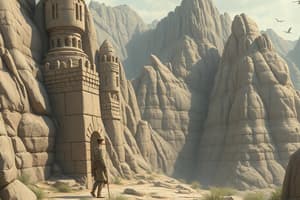Podcast
Questions and Answers
Field notes constitute the only reliable and permanent record of actual work done in the field.
Field notes constitute the only reliable and permanent record of actual work done in the field.
True (A)
Inaccurate or incomplete field notes can result in wasted time, money, and effort in data gathering.
Inaccurate or incomplete field notes can result in wasted time, money, and effort in data gathering.
True (A)
The quality of field work is reflected directly in the manner in which field notes are kept.
The quality of field work is reflected directly in the manner in which field notes are kept.
True (A)
Which of the following is NOT a type of field note?
Which of the following is NOT a type of field note?
What are the five main types of field notes?
What are the five main types of field notes?
Which of the following is NOT typically included in a field book?
Which of the following is NOT typically included in a field book?
To eliminate common mistakes in note-keeping, it is recommended to use a soft pencil for recording.
To eliminate common mistakes in note-keeping, it is recommended to use a soft pencil for recording.
Recording data directly in the field book immediately after a measurement is preferred.
Recording data directly in the field book immediately after a measurement is preferred.
What is the correct procedure for correcting a mistake in field notes?
What is the correct procedure for correcting a mistake in field notes?
It is acceptable to erase recorded data in a field book.
It is acceptable to erase recorded data in a field book.
Crowding observed data in field notes is encouraged to save space.
Crowding observed data in field notes is encouraged to save space.
Using a straight edge for ruling lines in field notes helps maintain accuracy and clarity.
Using a straight edge for ruling lines in field notes helps maintain accuracy and clarity.
Sketches are preferred over tabulations to avoid misinterpretation of data.
Sketches are preferred over tabulations to avoid misinterpretation of data.
North should be indicated at the top of the page of the field book for all sketches.
North should be indicated at the top of the page of the field book for all sketches.
Tabulated values should be lined up vertically, including the decimal point and digits.
Tabulated values should be lined up vertically, including the decimal point and digits.
Computations made in the field should be recorded in a separate notebook for later review.
Computations made in the field should be recorded in a separate notebook for later review.
Each page of the field book should be numbered.
Each page of the field book should be numbered.
What is the purpose of numbering each page in the field book?
What is the purpose of numbering each page in the field book?
Which of the following is NOT a member of a typical survey party?
Which of the following is NOT a member of a typical survey party?
What is the primary function of a flagman in a survey party?
What is the primary function of a flagman in a survey party?
What is the primary function of the rodman in a survey party?
What is the primary function of the rodman in a survey party?
Survey hand signals are used primarily for communicating warnings and instructions.
Survey hand signals are used primarily for communicating warnings and instructions.
Survey hand signals are used to avoid verbal communication in the field due to distance, noise, and wind conditions.
Survey hand signals are used to avoid verbal communication in the field due to distance, noise, and wind conditions.
What are the primary reasons why survey hand signals are used in the field?
What are the primary reasons why survey hand signals are used in the field?
Match the survey hand signals with their corresponding meanings:
Match the survey hand signals with their corresponding meanings:
It is important to be familiar with handling and caring for surveying instruments.
It is important to be familiar with handling and caring for surveying instruments.
Always use a surveying instrument if it's raining or snowing.
Always use a surveying instrument if it's raining or snowing.
It is crucial to check a surveying instrument's functionality before and after field work.
It is crucial to check a surveying instrument's functionality before and after field work.
It is safe to leave a surveying instrument sitting on unstable ground while in use.
It is safe to leave a surveying instrument sitting on unstable ground while in use.
When a surveying instrument gets wet, you should immediately place it back in its container.
When a surveying instrument gets wet, you should immediately place it back in its container.
It is considered acceptable to play with a surveying instrument as long as you don't damage it.
It is considered acceptable to play with a surveying instrument as long as you don't damage it.
When transporting survey equipment, always ensure the instrument is securely fastened.
When transporting survey equipment, always ensure the instrument is securely fastened.
Geomatics is a science concerned with the measurement, representation, analysis, and management, retrieval, and display of spatial information pertaining to the Earth's physical features.
Geomatics is a science concerned with the measurement, representation, analysis, and management, retrieval, and display of spatial information pertaining to the Earth's physical features.
Geomatics encompasses disciplines like surveying, geodesy, remote sensing, photogrammetry, cartography, geographic information systems, and global positioning systems.
Geomatics encompasses disciplines like surveying, geodesy, remote sensing, photogrammetry, cartography, geographic information systems, and global positioning systems.
The traditional definition of surveying is considered the most comprehensive definition in modern times.
The traditional definition of surveying is considered the most comprehensive definition in modern times.
The modern definition of surveying encompasses the determination of angular and linear measurements to establish the form, extent, and relative positioning of points, lines, and areas on the Earth's surface.
The modern definition of surveying encompasses the determination of angular and linear measurements to establish the form, extent, and relative positioning of points, lines, and areas on the Earth's surface.
The ancient Babylonians used surveying techniques in building structures.
The ancient Babylonians used surveying techniques in building structures.
The construction of the Great Pyramid in Egypt is a prominent example of the advanced surveying techniques applied in ancient times.
The construction of the Great Pyramid in Egypt is a prominent example of the advanced surveying techniques applied in ancient times.
Who is credited with first calculating the circumference of the Earth?
Who is credited with first calculating the circumference of the Earth?
The military requirements of World Wars I and II spurred advancements in surveying equipment and techniques.
The military requirements of World Wars I and II spurred advancements in surveying equipment and techniques.
Surveying plays a role in the establishment of land boundaries.
Surveying plays a role in the establishment of land boundaries.
Surveying is used in charting coastlines and navigable waterways.
Surveying is used in charting coastlines and navigable waterways.
Surveying plays a role in collecting data related to the Earth's magnetism.
Surveying plays a role in collecting data related to the Earth's magnetism.
What are the two main categories of surveying?
What are the two main categories of surveying?
Plane Surveying is a type of surveying where the Earth's surface is considered as a plane.
Plane Surveying is a type of surveying where the Earth's surface is considered as a plane.
Geodetic Surveying accounts for the Earth's true shape.
Geodetic Surveying accounts for the Earth's true shape.
What is the primary purpose of a Control Survey?
What is the primary purpose of a Control Survey?
Property Surveys are used to determine the boundaries of properties, including the lengths and directions of lot lines.
Property Surveys are used to determine the boundaries of properties, including the lengths and directions of lot lines.
Topographic Surveys are employed to gather data for creating topographic maps.
Topographic Surveys are employed to gather data for creating topographic maps.
What is the main purpose of a Hydrographic Survey?
What is the main purpose of a Hydrographic Survey?
Mine Surveys are used to map underground and surface works related to mining operations.
Mine Surveys are used to map underground and surface works related to mining operations.
Route Surveys are used to plan and design transportation infrastructure.
Route Surveys are used to plan and design transportation infrastructure.
Construction Surveys are performed to guide and monitor public and private engineering projects.
Construction Surveys are performed to guide and monitor public and private engineering projects.
Photogrammetric Surveys employ photographs to determine the position of objects.
Photogrammetric Surveys employ photographs to determine the position of objects.
What are the four main types of surveying equipment mentioned in the text?
What are the four main types of surveying equipment mentioned in the text?
Flashcards
Geomatics
Geomatics
The science of measuring, representing, analyzing, managing, retrieving, and displaying spatial information.
Traditional Geomatics
Traditional Geomatics
The art of making measurements of the relative positions of natural and man-made features on the earth's surface, and the presentation of this information either graphically or numerically.
Modern Geomatics
Modern Geomatics
The art and science of determining angular and linear measurements to establish the form, extent, and relative position of points, lines, and areas on or near the surface of the earth or on other extraterrestrial bodies through applied mathematics and the use of specialized equipment and techniques.
Field Notes
Field Notes
Signup and view all the flashcards
Recording Observed Data
Recording Observed Data
Signup and view all the flashcards
Correcting Mistakes in Field Notes
Correcting Mistakes in Field Notes
Signup and view all the flashcards
Deleting Field Notes Pages
Deleting Field Notes Pages
Signup and view all the flashcards
Avoiding Misinterpretation
Avoiding Misinterpretation
Signup and view all the flashcards
Sketching and Tabulating
Sketching and Tabulating
Signup and view all the flashcards
Recording Field Computations
Recording Field Computations
Signup and view all the flashcards
Numbering Field Notebook Pages
Numbering Field Notebook Pages
Signup and view all the flashcards
Survey Party
Survey Party
Signup and view all the flashcards
Survey Hand Signals
Survey Hand Signals
Signup and view all the flashcards
Care and Handling of Instruments
Care and Handling of Instruments
Signup and view all the flashcards
Caring for Wet Instruments
Caring for Wet Instruments
Signup and view all the flashcards
Plane Surveying
Plane Surveying
Signup and view all the flashcards
Geodetic Surveying
Geodetic Surveying
Signup and view all the flashcards
Control Survey
Control Survey
Signup and view all the flashcards
Property Survey
Property Survey
Signup and view all the flashcards
Topographic Survey
Topographic Survey
Signup and view all the flashcards
Hydrographic Survey
Hydrographic Survey
Signup and view all the flashcards
Mine Survey
Mine Survey
Signup and view all the flashcards
Route Survey
Route Survey
Signup and view all the flashcards
Construction Survey
Construction Survey
Signup and view all the flashcards
Photogrammetric Survey
Photogrammetric Survey
Signup and view all the flashcards
Level Surface
Level Surface
Signup and view all the flashcards
Zenith
Zenith
Signup and view all the flashcards
Nadir
Nadir
Signup and view all the flashcards
Study Notes
Surveying Fieldwork
- Field notes are the only reliable and permanent record of fieldwork.
- Inaccurate or incomplete notes waste time, money, and effort.
- The quality of fieldwork is directly reflected in the field record's keeping.
- Field notes become the official record of the survey.
Types of Field Notes
- Sketches
- Tabulations
- Explanatory notes
- Computations
- Combination
Information Found in Fieldbooks
- Title or Name of the Project
- Time of Day and Date
- Weather Conditions
- Names of Group Members and their designations
- List of Equipment
Recording Observed Data
- Follow a consistent, simple writing style.
- Use a sharp pencil.
- Record data directly in the field book after measurement, not on scratch paper.
- Do not erase recorded data. If incorrect, put a line through it and write the correct value above it. If the whole page is incorrect, draw diagonal lines and label "VOID".
- Avoid crowding the data.
- Bring a straight edge for ruling lines and a small protractor for angles.
- Use sketches and explanatory notes to avoid misinterpretation of data.
- Indicate north on the page and draw a meridian arrow for sketches.
- Keep tabulated values within columns, aligning the decimal point and digits vertically.
- Ensure data precision matches reality.
- Record computations in the field notebook for later checks.
- Ensure every page is numbered for correct data sequence.
Survey Party
- Chief of Party
- Assistant Chief of Party
- Instrument man
- Technician
- Data processor
- Recorder
- Head Tapeman
- Rear Tapeman
- Flagman
- Rodman
- Pacer
- Axeman or Lineman
- Aidman
- Utilitymen
Survey Hand Signals
- Signals use arm and hand motions to convey information, commands, directions, or warnings.
- They are often used when verbal communication is difficult due to distance, wind, or noise.
Survey Hand Signals (Details)
(Illustrated notes, likely with diagrams or pictures, not included here)
- Illustrated guide to hand signals for specific numbers (1-9).
Care and Handling of Instruments
- Know how to use instruments.
- Place them on stable ground when used.
- Store properly in containers.
- Don't use them in unsuitable weather.
- Check functionality before and after fieldwork.
- Carefully dry wet instruments before storing.
- Be mindful of surroundings while transporting.
- Avoid playing with the instruments.
- Ensure secure transportation of instruments.
Geomatics
- The science of measuring, representing, analyzing, managing, retrieving, and displaying spatial information, including Earth's physical features and built environments.
Geomatics Disciplines
- Surveying
- Geodesy
- Remote Sensing and Photogrammetry
- Cartography
- Geographic Information Systems
- Global Positioning Systems
Geomatics (Traditional Definition)
- The art of measuring and recording relative positions of natural and man-made features on Earth's surface, presenting it graphically or numerically.
Geomatics (Modern Definition)
- The art and science of determining angular and linear measurements to define the form, extent, and relative positions of points, lines, and areas on or near Earth's surface (or other bodies) using applied mathematics and specialized equipment/techniques.
History of Surveying (Examples)
- Babylon (ancient surveying/record-keeping methods illustrated)
- Egypt (ancient surveying/record-keeping methods illustrated)
- Eratosthenes (ancient Greek scientist who measured Earth's circumference illustrated).
Other (Quotes and Motivations)
- "What can be mapped, could be ruled."
- Military requirements from World Wars I and II spurred improvements in surveying equipment and techniques.
Uses of Survey
- Establishing land boundaries
- Fixing national/state boundaries
- Charting coastlines and navigable water bodies
- Precisely locating reference points
- Collecting data on Earth's magnetism
Types of Surveys
- Control Surveys (establishing horizontal and vertical positions of arbitrary points).
- Property Surveys (determining lot lines and their positions).
- Topographic Surveys (creating topographic maps of terrain and features).
- Hydrographic Surveys (surveys of water bodies for navigation, water supply, or subaqueous construction).
- Mine Surveys (locating underground and surface works linked to mining).
- Route Surveys (planning and constructing transportation lines).
- Construction Surveys (laying out, locating, and monitoring engineering works).
- Photogrammetric Surveys (using photographs to determine object positions)
Definitions of Terms
- Level surface (curved surface normal to gravity line)
- Zenith (direction from center of Earth above observer)
- Nadir (direction from center of Earth below observer)
- Horizontal plane (tangent to the level surface at a point)
- Horizontal line (tangent to the level surface)
- Horizontal angle (angle formed by intersecting horizontal lines).
- Vertical line (perpendicular to the horizontal plane)
- Vertical plane (plane that contains a vertical line)
- Vertical angle (angle formed by two intersecting vertical lines)
- Zenith angle (angle formed by lines directed toward and away from the zenith).
- Nadir angle (angle formed by lines directed toward and away from the nadir).
- Horizontal distances (distances along a level line)
- Elevation of a point (vertical distance relative to datum).
- Contour (imaginary line of constant elevation)
- Difference in elevation (vertical distance between two points).
- Levelling (method for measuring difference in elevation)
- Grade/Gradient of a line (slope of a line)
Studying That Suits You
Use AI to generate personalized quizzes and flashcards to suit your learning preferences.




